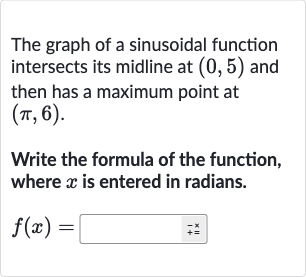Full solution
Q. The graph of a sinusoidal function intersects its midline at and then has a maximum point at .Write the formula of the function, where is entered in radians.
- Find Amplitude: Determine the amplitude of the function.Since the midline is at and the maximum point is at , the amplitude () is the distance from the midline to the maximum, which is .
- Determine Vertical Shift: Determine the vertical shift . The midline of the function represents the vertical shift. Since the function intersects the midline at , the vertical shift is .
- Calculate Period: Determine the period of the function. The function reaches its maximum at , and since it's a sinusoidal function, the next maximum would be at (for a full cycle). Therefore, the period () is .
- Calculate Value of B: Determine the value of in the function . The period is related to by the formula . Since , we have , which gives us .
- Determine Phase Shift: Determine the phase shift .Since the function intersects its midline at , there is no horizontal shift to the left or right. Therefore, the phase shift is .
- Write Function Equation: Write the equation of the function using the determined values.We have , , , and . The function is , which simplifies to .
More problems from Transformations of absolute value functions: translations and reflections
QuestionGet tutor help
QuestionGet tutor help
QuestionGet tutor help
QuestionGet tutor help
QuestionGet tutor help
QuestionGet tutor help
QuestionGet tutor help
QuestionGet tutor help
QuestionGet tutor help

